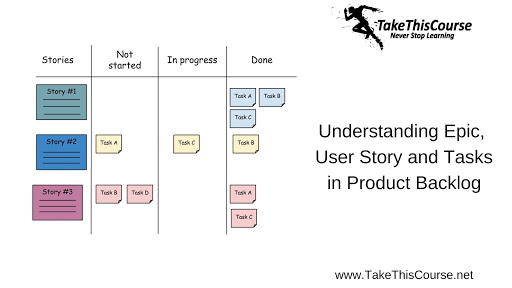Scrum Alliance® is the largest membership and certification organization in the Agile community. Csm Certification is given by Scrum Alliance Ken Schwaber founder member of Scrum Alliance left the Scrum Alliance in late 2009 and founded Scrum.org which oversees the parallel Professional Scrum accreditation series.We at takethiscourse.net provides Csm practice Test and Psm Dumps to prepare students for thier actual exam.Visit takethiscourse medium blog to know ,what are the easiest and cheapest ways to pass the Psm Dumps?
Key members who understanding Epic,User Story and Tasks in Product Backlog are Scrum Masters.
INTODUCTION:
In an agile
framework, you must have often heard different terms like epic, user story, and
tasks in a product backlog, right? But most of the learners are always confused
about these terms and their purpose. So that is why we at taekthiscourse.net
thought why not we discuss all these three terms in detail with you and help
you understand what they are and how they are used in a product backlog in an
agile framework.
Understanding what epic is:
Epic is a
user story but not a complete one. In other words, it is such a kind of user
story that has not been detailed yet and is rather quite long. The epic is
mostly packed with, full of uncertainties and that is why it cannot be turned
into product incrementation. That is why it is important to slice epic into
smaller user stories and turn it into a short form from a long one and then use
it further.
Why do we need an epic?
With the
help of an epic, we are able to track large ideas in a product backlog without
overpopulating it with multiple items. It is because of epics that a hierarchy
for the backlog items is established where epic presents the original idea that
is often related to a particular result or outcome.
User Story (US):
In the easiest
words, a user story is a very short format that is used to write down the
requirements for building a product. Whatever the client or customer demands
are written in the User Story and it has to be intelligible to clients and
customers. It can be an informal and general explanation of a software feature
that is always written from the perspective of an end-user. Thus its purpose is
to articulate how a software feature will provide value to an end-user or
customer.
Purpose of User Story:
As the user
story is what the customer is demanding from us, thus its purpose is to
articulate how a piece of work done by the team is going to deliver a
particular value back to the customer. Whatever the client demands are in the
user story and when the team has a clear idea of what to deliver, the chances
of a satisfied client are very high. Thus a user story saves the day by
briefing us what the client wants.
Understanding tasks in product backlog:
Tasks are
known to be the most important items for a user story that has to become an
increment to a product. Precisely whatever the items are mandatory for a story
is mentioned in the tasks and has to be taken care of by the team.
Purpose of tasks:
It is
because of tasks, all of the items that are mentioned in the user story become
an addition to the product and are according to what the client demands. You
can consider this as a list of things that are needed to be done or are
demanded. Some examples of tasks in a product backlog are.
·
Acquiring speakers.
·
Assembling the new
signs.
·
Creating different
engineering models.
·
Installing signs all
around the 7th floor.
·
Acquiring a presence
sensor module.
And many
more. As you can see from the above examples, these tasks mentioned have to be
completed no matter the circumstance is. And thus become an addition to the
product.
Conclusion:
As you can
see from the above explanation of three terms, some of the agile methods are
quite tough for someone who is just beginning. And when it is about the project
management world, it can take some time to get used to the terms and how things
work. But everything becomes clear with time and one gets used to them in no
time.

No comments:
Post a Comment